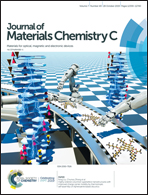Electrochemical interfacing of Prussian blue nanocrystals with an ITO electrode modified with a thin film containing a Ru complex†
Abstract
Prussian blue (PB) is a well-known porous metal–organic framework (MOF) material, whose redox chemistry on indium-tin oxide (ITO) electrodes has been studied extensively. However, the molecular interfacing of PB nanocrystals has not yet been explored in such detail. In this study, electrochemical interfacing of PB nanocrystals with a thin film containing a redox-active Ru complex (Ru-NP) was investigated. Spontaneous growth of preferentially oriented PB nanocrystals was observed on an ITO electrode modified with a Ru-NP primer film, which was subsequently characterized by UV-Vis-NIR spectroscopy, scanning electron microscopy (SEM), and X-ray diffraction (XRD) analysis. Blocking and rectification of electron transport (ET) were observed between PB and the Ru complex, and this behavior was governed by the energy gap between the Ru complex and PB nanocrystals as well as the thickness of the Ru-containing primer layer film. ET rectification at the ITO‖(Ru-NP)3/PB heterojunction was supported by a potential-step chronoamperometry (PSCA) analysis of the i–t curves. Owing to the large difference between the forward and backward ET rates at the ITO‖(Ru-NP)3/PB heterojunction, a large hysteresis loop was observed during electrochemical quartz crystal microbalance (EQCM) measurements, indicating dynamic ion transfer gating in the PB nanopores through the rectified electron transport between the Ru-NP layer and the ITO electrode at the ITO‖(Ru-NP)3/PB heterojunction.



 Please wait while we load your content...
Please wait while we load your content...